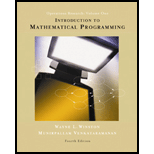
Introduction to mathematical programming
4th Edition
ISBN: 9780534359645
Author: Jeffrey B. Goldberg
Publisher: Cengage Learning
expand_more
expand_more
format_list_bulleted
Concept explainers
Expert Solution & Answer
Chapter 4.7, Problem 5P
Explanation of Solution
Min problem:
- For a min problem, an LP is unbounded if there is a variable with a positive coefficient in Row 0 that has a non-positive coefficient in each constraint.
- Here the optimal table is
| z | x1 | x2 | s1 | s2 | RHS |
| 1 | 2 | 3 | 0 | 0 | 0 |
| 0 | 1 | -1 | 1 | 0 | 1 |
| 0 | 1 | -2 | 0 | 1 | 2 |
- Here x2 is as large as desired.
- Since each unit by which x2 is increased decreases z by 3 units.
- Hence z is taken as small as desired...
Expert Solution & Answer
Want to see the full answer?
Check out a sample textbook solution
Students have asked these similar questions
It is unclear why each LP has an optimal fundamental feasible solution.
In regards of the problem:max cTx subject to Ax = b, with an optimal solution of value v. Suppose the problem min cT x, subject to Ax = b have great with the same value, v. It can be concluded that there is a singlegood point for both? How is the feasible region geometrically?
Solve the following graphically:
Max z = 3x1 + 4x2
subject to x1 + 2x2 ≤ 16
2x1 + 3x2 ≤ 18
x1 ≥ 2
x2 ≤ 10
x1, x2 ≥ 0
What are the optimal values of x1, x2, and z?
Group of answer choices
x1 = 93, x2 = 0, z = 48
x1 = 19, x2 = 0, z = 32
x1 = 10, x2 = 0, z = 27
x1 = 9, x2 = 0, z = 27
x1 = 9, x2 = 3, z = 30
x1 = 12, x2 = 6, z = 42
Chapter 4 Solutions
Introduction to mathematical programming
Ch. 4.1 - Prob. 1PCh. 4.1 - Prob. 2PCh. 4.1 - Prob. 3PCh. 4.4 - Prob. 1PCh. 4.4 - Prob. 2PCh. 4.4 - Prob. 3PCh. 4.4 - Prob. 4PCh. 4.4 - Prob. 5PCh. 4.4 - Prob. 6PCh. 4.4 - Prob. 7P
Ch. 4.5 - Prob. 1PCh. 4.5 - Prob. 2PCh. 4.5 - Prob. 3PCh. 4.5 - Prob. 4PCh. 4.5 - Prob. 5PCh. 4.5 - Prob. 6PCh. 4.5 - Prob. 7PCh. 4.6 - Prob. 1PCh. 4.6 - Prob. 2PCh. 4.6 - Prob. 3PCh. 4.6 - Prob. 4PCh. 4.7 - Prob. 1PCh. 4.7 - Prob. 2PCh. 4.7 - Prob. 3PCh. 4.7 - Prob. 4PCh. 4.7 - Prob. 5PCh. 4.7 - Prob. 6PCh. 4.7 - Prob. 7PCh. 4.7 - Prob. 8PCh. 4.7 - Prob. 9PCh. 4.8 - Prob. 1PCh. 4.8 - Prob. 2PCh. 4.8 - Prob. 3PCh. 4.8 - Prob. 4PCh. 4.8 - Prob. 5PCh. 4.8 - Prob. 6PCh. 4.10 - Prob. 1PCh. 4.10 - Prob. 2PCh. 4.10 - Prob. 3PCh. 4.10 - Prob. 4PCh. 4.10 - Prob. 5PCh. 4.11 - Prob. 1PCh. 4.11 - Prob. 2PCh. 4.11 - Prob. 3PCh. 4.11 - Prob. 4PCh. 4.11 - Prob. 5PCh. 4.11 - Prob. 6PCh. 4.12 - Prob. 1PCh. 4.12 - Prob. 2PCh. 4.12 - Prob. 3PCh. 4.12 - Prob. 4PCh. 4.12 - Prob. 5PCh. 4.12 - Prob. 6PCh. 4.13 - Prob. 2PCh. 4.14 - Prob. 1PCh. 4.14 - Prob. 2PCh. 4.14 - Prob. 3PCh. 4.14 - Prob. 4PCh. 4.14 - Prob. 5PCh. 4.14 - Prob. 6PCh. 4.14 - Prob. 7PCh. 4.16 - Prob. 1PCh. 4.16 - Prob. 2PCh. 4.16 - Prob. 3PCh. 4.16 - Prob. 5PCh. 4.16 - Prob. 7PCh. 4.16 - Prob. 8PCh. 4.16 - Prob. 9PCh. 4.16 - Prob. 10PCh. 4.16 - Prob. 11PCh. 4.16 - Prob. 12PCh. 4.16 - Prob. 13PCh. 4.16 - Prob. 14PCh. 4.17 - Prob. 1PCh. 4.17 - Prob. 2PCh. 4.17 - Prob. 3PCh. 4.17 - Prob. 4PCh. 4.17 - Prob. 5PCh. 4.17 - Prob. 7PCh. 4.17 - Prob. 8PCh. 4 - Prob. 1RPCh. 4 - Prob. 2RPCh. 4 - Prob. 3RPCh. 4 - Prob. 4RPCh. 4 - Prob. 5RPCh. 4 - Prob. 6RPCh. 4 - Prob. 7RPCh. 4 - Prob. 8RPCh. 4 - Prob. 9RPCh. 4 - Prob. 10RPCh. 4 - Prob. 12RPCh. 4 - Prob. 13RPCh. 4 - Prob. 14RPCh. 4 - Prob. 16RPCh. 4 - Prob. 17RPCh. 4 - Prob. 18RPCh. 4 - Prob. 19RPCh. 4 - Prob. 20RPCh. 4 - Prob. 21RPCh. 4 - Prob. 22RPCh. 4 - Prob. 23RPCh. 4 - Prob. 24RPCh. 4 - Prob. 26RPCh. 4 - Prob. 27RPCh. 4 - Prob. 28RP
Knowledge Booster
Learn more about
Need a deep-dive on the concept behind this application? Look no further. Learn more about this topic, computer-science and related others by exploring similar questions and additional content below.Similar questions
- Why any LP with an optimal solution has an optimal basic feasible solution?arrow_forwardIf 142 and 155 are two feasible solutions for a primal minimization problem, whereas 122 and 130 are two feasible solutions for the associated dual maximization problem. Which of the following statements is the most correct? 122 <= Optimal solution <= 155 O b. 122 <= Optimal solution <= 142 D DC 130 <= Optimal solution <= 142 Od 130 <= Optimal solution <= 155arrow_forwardConsider the following linear programming model: Max 2X1 + 3X2 Subject to: X1 ≤ 2 X2 ≤ 3 X1 ≤ 1 X1, X2 ≥ 0 This linear programming model has: a. alternate optimal solutions b. infeasible solution c. redundant constraint d. unbounded solutionarrow_forward
Recommended textbooks for you
 Operations Research : Applications and AlgorithmsComputer ScienceISBN:9780534380588Author:Wayne L. WinstonPublisher:Brooks Cole
Operations Research : Applications and AlgorithmsComputer ScienceISBN:9780534380588Author:Wayne L. WinstonPublisher:Brooks Cole

Operations Research : Applications and Algorithms
Computer Science
ISBN:9780534380588
Author:Wayne L. Winston
Publisher:Brooks Cole